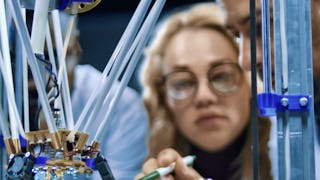Hello, everyone! Welcome to this course on Using Rapid Prototyping in the Engineering Design Process. This is part of the Rapid Prototyping and Tooling specialization. In this course, I’ll cover the engineering design process and how it can be used to solve open-ended problems. I’ll discuss the different stages of prototyping and why it is advantageous to produce prototypes rapidly. I’ll then discuss engineering drawings and how to communicate information about 3-dimensional objects on 2-dimensional mediums such as paper or a computer screen. Finally, I’ll end this course by discussing computer-aided design, also known as CAD, and how it can greatly assist in making prototypes.

Enjoy unlimited growth with a year of Coursera Plus for $199 (regularly $399). Save now.

Using Rapid Prototyping in the Engineering Design Process
This course is part of Rapid Prototyping and Tooling Specialization

Instructor: Daniel Frank
1,921 already enrolled
Included with
(29 reviews)
Recommended experience
What you'll learn
You will understand the basics of rapid prototyping and its relationship to the engineering design process.
Skills you'll gain
Details to know

Add to your LinkedIn profile
7 assignments
See how employees at top companies are mastering in-demand skills

Build your subject-matter expertise
- Learn new concepts from industry experts
- Gain a foundational understanding of a subject or tool
- Develop job-relevant skills with hands-on projects
- Earn a shareable career certificate

There are 4 modules in this course
Hello, everyone! Welcome to this course on Using Rapid Prototyping in the Engineering Design Process. This is part of the Rapid Prototyping and Tooling specialization. In this course, I’ll cover the engineering design process and how it can be used to solve open-ended problems. I’ll discuss the different stages of prototyping and why it is advantageous to produce prototypes rapidly. I’ll then discuss engineering drawings and how to communicate information about 3-dimensional objects on 2-dimensional mediums such as paper or a computer screen. Finally, I’ll end this course by discussing computer-aided design, also known as CAD, and how it can greatly assist in making prototypes. By exploring many examples from different robotics projects I’ve had the opportunity to work on, by the end of this course, you should have a better understanding of the engineering design process and where rapid prototyping fits into it, as well as some tools to help you with developing high-quality prototypes. There’s a lot of awesome content to cover, so without further ado, let’s dive into the world of rapid prototyping!
What's included
3 videos2 readings
In this module, you will learn about the engineering design process and how it can be used to solve open-ended problems.
What's included
3 videos2 assignments
In this module, you will learn about the different types of prototypes and the advantages to producing them rapidly.
What's included
3 videos2 assignments
In this module, you will learn about the challenges and best practices when conveying information about a 3-dimensional object on a 2-dimensional surface and how CAD can aid in the prototyping process.
What's included
3 videos3 assignments
Earn a career certificate
Add this credential to your LinkedIn profile, resume, or CV. Share it on social media and in your performance review.
Instructor

Offered by
Explore more from Mechanical Engineering
 Status: Free Trial
Status: Free TrialArizona State University
 Status: Free Trial
Status: Free TrialArizona State University
 Status: Free Trial
Status: Free TrialArizona State University
 Status: Free Trial
Status: Free TrialUniversity of Colorado Boulder
Why people choose Coursera for their career




Learner reviews
29 reviews
- 5 stars
82.75%
- 4 stars
17.24%
- 3 stars
0%
- 2 stars
0%
- 1 star
0%
Showing 3 of 29
Reviewed on Sep 2, 2024
had a great time understanding these techniques which will help bring more clarity adding to our professionalism
Reviewed on Oct 3, 2023
Very informative and inspiring course in rapid prototyping.

Open new doors with Coursera Plus
Unlimited access to 10,000+ world-class courses, hands-on projects, and job-ready certificate programs - all included in your subscription
Advance your career with an online degree
Earn a degree from world-class universities - 100% online
Join over 3,400 global companies that choose Coursera for Business
Upskill your employees to excel in the digital economy
Frequently asked questions
To access the course materials, assignments and to earn a Certificate, you will need to purchase the Certificate experience when you enroll in a course. You can try a Free Trial instead, or apply for Financial Aid. The course may offer 'Full Course, No Certificate' instead. This option lets you see all course materials, submit required assessments, and get a final grade. This also means that you will not be able to purchase a Certificate experience.
When you enroll in the course, you get access to all of the courses in the Specialization, and you earn a certificate when you complete the work. Your electronic Certificate will be added to your Accomplishments page - from there, you can print your Certificate or add it to your LinkedIn profile.
Yes. In select learning programs, you can apply for financial aid or a scholarship if you can’t afford the enrollment fee. If fin aid or scholarship is available for your learning program selection, you’ll find a link to apply on the description page.
More questions
Financial aid available,

